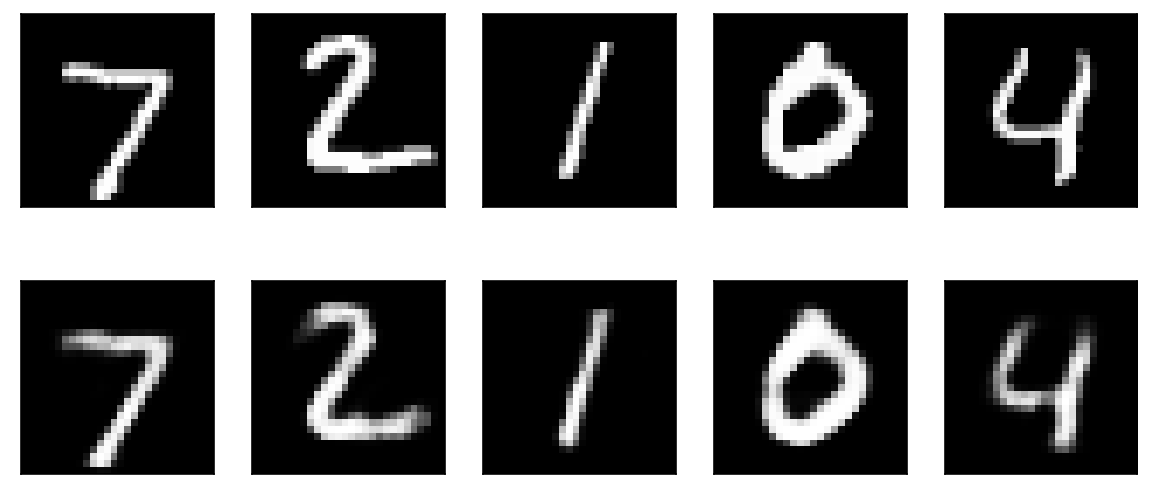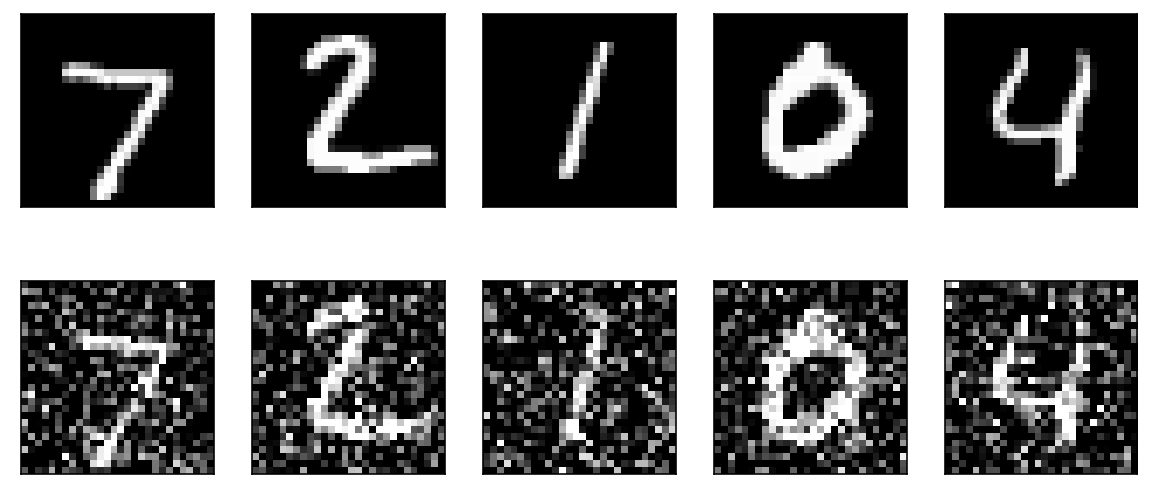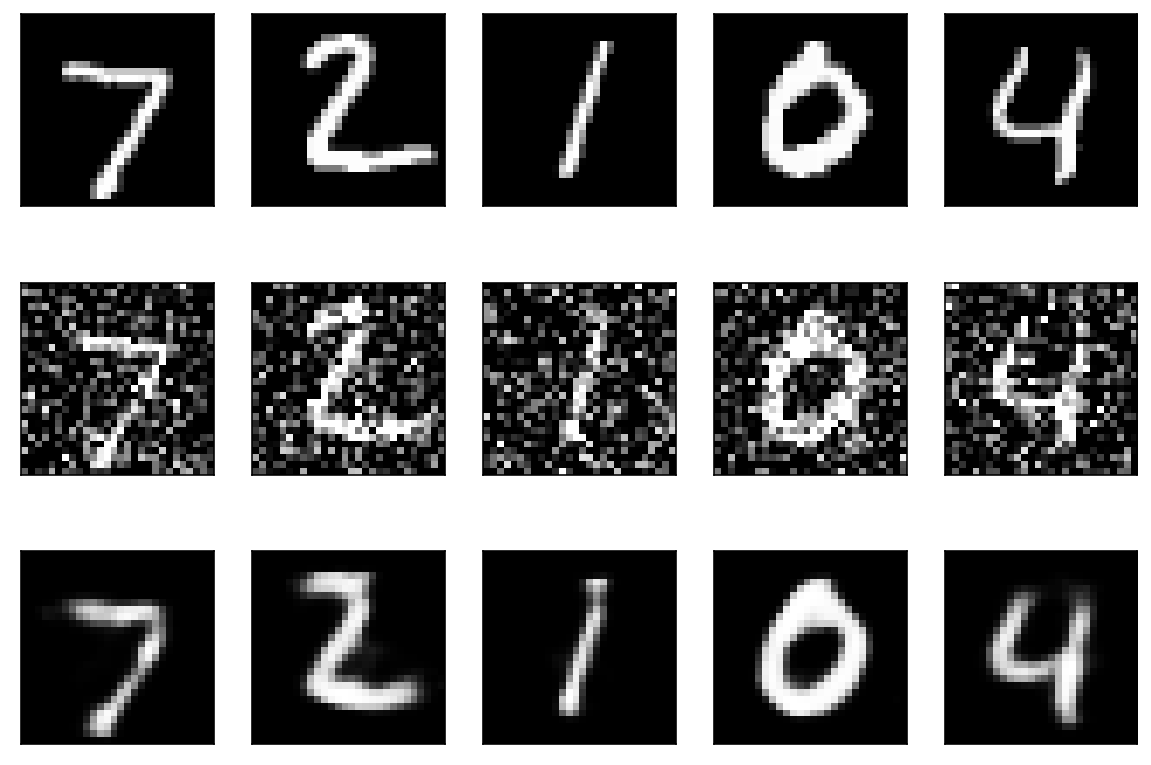AUTO ENCODER
In this notebook you will find how auto encoder are trained in tensorflow(Keras). This notebook have two different type of encoder i.e normal * Auto Encoder * and * Denoising Auto Encoder * .
Normal Encoder
LIBRARY ARE LOADED
1
2
3
4
5
6
7
8
9
10
11
12
13
14
15
16
|
%matplotlib inline
%config InlineBackend.figure_format = 'retina'
import matplotlib.pyplot as plt
import pandas as pd
import numpy as np
import seaborn as sns
import warnings
warnings.filterwarnings('ignore')
#from __future__ import print_function
from keras.models import Model
from keras.layers import Dense, Input
from keras.datasets import mnist
from keras.regularizers import l1
from keras.optimizers import Adam
|
FOR PLOTING OUTPUTS
1
2
3
4
5
6
7
8
9
10
11
12
13
14
15
16
17
18
19
20
21
22
23
24
25
|
def plot_autoencoder_outputs(autoencoder, n, dims):
decoded_imgs = autoencoder.predict(x_test)
# number of example digits to show
n = 5
plt.figure(figsize=(10, 4.5))
for i in range(n):
# plot original image
ax = plt.subplot(2, n, i + 1)
plt.imshow(x_test[i].reshape(*dims))
plt.gray()
ax.get_xaxis().set_visible(False)
ax.get_yaxis().set_visible(False)
if i == n/2:
ax.set_title('Original Images')
# plot reconstruction
ax = plt.subplot(2, n, i + 1 + n)
plt.imshow(decoded_imgs[i].reshape(*dims))
plt.gray()
ax.get_xaxis().set_visible(False)
ax.get_yaxis().set_visible(False)
if i == n/2:
ax.set_title('Reconstructed Images')
plt.show()
|
TRAIN TEST SPLITS
1
2
3
4
|
(x_train, y_train), (x_test, y_test) = mnist.load_data()
x_train = x_train.astype('float32') / 255.0
x_test = x_test.astype('float32') / 255.0
|
RESIZED FOR PROCESSING
1
2
3
4
5
|
x_train = x_train.reshape((len(x_train), np.prod(x_train.shape[1:])))
x_test = x_test.reshape((len(x_test), np.prod(x_test.shape[1:])))
print(x_train.shape)
print(x_test.shape)
|
(60000, 784)
(10000, 784)
MODEL CREATION
1
2
3
4
5
6
7
8
9
10
11
12
13
|
input_size = 784
hidden_size = 128
code_size = 32
input_img = Input(shape=(input_size,))
hidden_1 = Dense(hidden_size, activation='relu')(input_img)
code = Dense(code_size, activation='relu')(hidden_1)
hidden_2 = Dense(hidden_size, activation='relu')(code)
output_img = Dense(input_size, activation='sigmoid')(hidden_2)
autoencoder = Model(input_img, output_img)
autoencoder.compile(optimizer='adam', loss='binary_crossentropy')
autoencoder.fit(x_train, x_train, epochs=3)
|
Epoch 1/3
1875/1875 [==============================] - 29s 2ms/step - loss: 0.1880
Epoch 2/3
1875/1875 [==============================] - 5s 3ms/step - loss: 0.1003
Epoch 3/3
1875/1875 [==============================] - 4s 2ms/step - loss: 0.0950
<keras.callbacks.History at 0x7fc58b7709d0>
MODEL SUMMARY(ARC.)
Model: "model"
_________________________________________________________________
Layer (type) Output Shape Param #
=================================================================
input_1 (InputLayer) [(None, 784)] 0
_________________________________________________________________
dense (Dense) (None, 128) 100480
_________________________________________________________________
dense_1 (Dense) (None, 32) 4128
_________________________________________________________________
dense_2 (Dense) (None, 128) 4224
_________________________________________________________________
dense_3 (Dense) (None, 784) 101136
=================================================================
Total params: 209,968
Trainable params: 209,968
Non-trainable params: 0
_________________________________________________________________
MODEL OUTPUT
1
|
plot_autoencoder_outputs(autoencoder, 5, (28, 28))
|
MODEL TEST
1
2
3
4
5
6
|
l=np.zeros((28,12))
m=np.ones((28,4))*0.8
r=np.zeros((28,12))
I=np.concatenate((l,m,r),axis=1).reshape(1,784)
plt.imshow(I.reshape(28,28))
L= autoencoder.predict(I)
|
1
2
3
|
print(L.shape)
plt.figure(figsize=(8, 8))
plt.imshow(L.reshape(28,28))
|
<matplotlib.image.AxesImage at 0x7fc57026c700>
MODEL WEIGHTS VISUALIZATION
1
2
3
4
5
6
7
8
9
10
|
weights = autoencoder.get_weights()[0].T
n = 10
plt.figure(figsize=(20, 5))
for i in range(n):
ax = plt.subplot(1, n, i + 1)
plt.imshow(weights[i+0].reshape(28, 28))
ax.get_xaxis().set_visible(False)
ax.get_yaxis().set_visible(False)
|
DENOISING AUTO ENCODER
DATA CREATION
1
2
3
4
5
6
7
8
9
10
11
12
13
14
15
16
17
18
19
20
21
22
23
24
25
26
27
28
|
noise_factor = 0.4
x_train_noisy = x_train + noise_factor * np.random.normal(size=x_train.shape)
x_test_noisy = x_test + noise_factor * np.random.normal(size=x_test.shape)
x_train_noisy = np.clip(x_train_noisy, 0.0, 1.0)
x_test_noisy = np.clip(x_test_noisy, 0.0, 1.0)
n = 5
plt.figure(figsize=(10, 4.5))
for i in range(n):
# plot original image
ax = plt.subplot(2, n, i + 1)
plt.imshow(x_test[i].reshape(28, 28))
plt.gray()
ax.get_xaxis().set_visible(False)
ax.get_yaxis().set_visible(False)
if i == n/2:
ax.set_title('Original Images')
# plot noisy image
ax = plt.subplot(2, n, i + 1 + n)
plt.imshow(x_test_noisy[i].reshape(28, 28))
plt.gray()
ax.get_xaxis().set_visible(False)
ax.get_yaxis().set_visible(False)
if i == n/2:
ax.set_title('Noisy Input')
|
MODEL
1
2
3
4
5
6
7
8
9
10
11
12
13
|
input_size = 784
hidden_size = 128
code_size = 32
input_img = Input(shape=(input_size,))
hidden_1 = Dense(hidden_size, activation='relu')(input_img)
code = Dense(code_size, activation='relu')(hidden_1)
hidden_2 = Dense(hidden_size, activation='relu')(code)
output_img = Dense(input_size, activation='sigmoid')(hidden_2)
autoencoder = Model(input_img, output_img)
autoencoder.compile(optimizer='adam', loss='binary_crossentropy')
autoencoder.fit(x_train_noisy, x_train, epochs=10)
|
Epoch 1/10
1875/1875 [==============================] - 7s 2ms/step - loss: 0.2093
Epoch 2/10
1875/1875 [==============================] - 3s 2ms/step - loss: 0.1309
Epoch 3/10
1875/1875 [==============================] - 4s 2ms/step - loss: 0.1219
Epoch 4/10
1875/1875 [==============================] - 3s 2ms/step - loss: 0.1181
Epoch 5/10
1875/1875 [==============================] - 3s 2ms/step - loss: 0.1161
Epoch 6/10
1875/1875 [==============================] - 5s 2ms/step - loss: 0.1143
Epoch 7/10
1875/1875 [==============================] - 5s 2ms/step - loss: 0.1132
Epoch 8/10
1875/1875 [==============================] - 4s 2ms/step - loss: 0.1124
Epoch 9/10
1875/1875 [==============================] - 3s 2ms/step - loss: 0.1115
Epoch 10/10
1875/1875 [==============================] - 4s 2ms/step - loss: 0.1113
<keras.callbacks.History at 0x7fc570466790>
PLOTING DATA
1
2
3
4
5
6
7
8
9
10
11
12
13
14
15
16
17
18
19
20
21
22
23
24
25
26
27
28
29
30
31
32
|
n = 5
plt.figure(figsize=(10, 7))
images = autoencoder.predict(x_test_noisy)
for i in range(n):
# plot original image
ax = plt.subplot(3, n, i + 1)
plt.imshow(x_test[i].reshape(28, 28))
plt.gray()
ax.get_xaxis().set_visible(False)
ax.get_yaxis().set_visible(False)
if i == n/2:
ax.set_title('Original Images')
# plot noisy image
ax = plt.subplot(3, n, i + 1 + n)
plt.imshow(x_test_noisy[i].reshape(28, 28))
plt.gray()
ax.get_xaxis().set_visible(False)
ax.get_yaxis().set_visible(False)
if i == n/2:
ax.set_title('Noisy Input')
# plot noisy image
ax = plt.subplot(3, n, i + 1 + 2*n)
plt.imshow(images[i].reshape(28, 28))
plt.gray()
ax.get_xaxis().set_visible(False)
ax.get_yaxis().set_visible(False)
if i == n/2:
ax.set_title('Autoencoder Output')
|
WEIGHT VISUALIZATION
1
2
3
4
5
6
7
8
9
10
|
weights = autoencoder.get_weights()[0].T
n = 10
plt.figure(figsize=(20, 5))
for i in range(n):
ax = plt.subplot(1, n, i + 1)
plt.imshow(weights[i+0].reshape(28, 28))
ax.get_xaxis().set_visible(False)
ax.get_yaxis().set_visible(False)
|
THANKS






